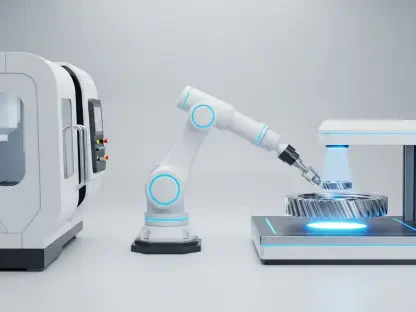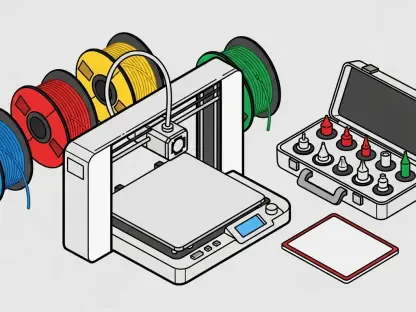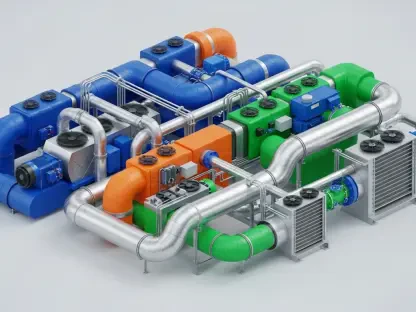Imagine a world where the aerospace and medical industries can produce critical components at a fraction of the current cost, without compromising on strength or reliability. This vision is inching closer to reality thanks to a groundbreaking development by engineers at RMIT University in Melbourne, Australia. Their latest innovation—a new titanium alloy designed specifically for Additive Manufacturing (AM), or 3D printing—promises to revolutionize how high-performance materials are created. By slashing costs by roughly one-third compared to traditional titanium alloys, this advancement tackles one of the biggest hurdles in AM adoption: affordability. Beyond just savings, the alloy offers enhanced strength and durability, making it a game-changer for industries that rely on precision and resilience. As manufacturing continues to evolve with digital technologies, such a material breakthrough could redefine production standards and open doors to wider applications, setting a new benchmark for what 3D printing can achieve in practical, real-world scenarios.
Breaking Barriers in Cost and Performance
A significant challenge in 3D printing has always been the high cost of materials, particularly titanium alloys like Ti-6Al-4V, which are widely used but prohibitively expensive due to elements like vanadium. The RMIT team has addressed this by developing an alloy that substitutes costly components with more affordable, readily available alternatives, cutting production expenses dramatically. This cost reduction—estimated at about one-third less than traditional options—makes the technology far more accessible for industries such as aerospace, where lightweight yet strong materials are essential. Moreover, this isn’t just about savings; the alloy’s performance metrics outshine those of its predecessors, offering a compelling combination of economic and functional benefits. Such a dual advantage could encourage broader adoption of AM technologies, especially among manufacturers who have hesitated due to budget constraints, paving the way for more innovative designs and applications in highly specialized fields.
Equally impressive is the enhanced strength and ductility of this new titanium alloy, which surpasses the capabilities of standard materials used in 3D printing. Traditional alloys often struggle to fully harness the potential of AM, resulting in parts that may not meet the rigorous demands of critical applications. The RMIT innovation, however, pushes beyond these limitations by delivering superior mechanical properties, ensuring that printed components are not only robust but also reliable under stress. This leap forward addresses long-standing concerns about the viability of 3D-printed parts in high-stakes environments like medical implants or aircraft structures. By achieving such high performance at a reduced cost, the alloy positions AM as a competitive alternative to conventional manufacturing methods, potentially shifting how industries approach production challenges and inspiring confidence in adopting cutting-edge solutions for complex engineering needs.
Innovating Material Design for Additive Manufacturing
One of the standout aspects of RMIT’s achievement lies in the novel design framework crafted by the research team to streamline the selection of alloying elements for AM. This methodical approach significantly cuts down on the time and expense traditionally associated with material development, offering a more efficient path to innovation. A key issue in 3D printing has been the formation of columnar microstructures, which often lead to uneven mechanical properties in printed parts. The RMIT solution eliminates these inconsistent grain structures, resulting in a titanium alloy with uniform characteristics that enhance reliability. Such consistency is vital for industrial applications where even minor flaws can have serious consequences, making this advancement a critical step toward standardizing high-quality AM outputs across various sectors.
Beyond the technical merits, the practical implications of this design framework are profound, as it sets a precedent for future alloy development tailored specifically to the unique demands of 3D printing. By addressing core challenges like material inconsistency, the RMIT team has created a blueprint that other researchers and manufacturers can build upon to tackle similar obstacles in AM. This approach not only improves the current alloy but also fosters a deeper understanding of how to optimize materials for digital manufacturing processes. As industries increasingly turn to AM for customized and on-demand production, having a reliable method to develop cost-effective, high-performance materials will be indispensable. This framework could accelerate the pace of innovation, ensuring that AM continues to evolve as a cornerstone of modern manufacturing, capable of meeting the diverse needs of global markets with precision and efficiency.
Paving the Way for Industry Adoption
To ensure this titanium alloy moves from lab to market, the RMIT team has taken concrete steps toward validation and commercialization, engaging with stakeholders from aerospace, automotive, and medical technology sectors. Market feedback gathered through initiatives like CSIRO’s ON Prime program has highlighted a strong demand for materials that offer substantial improvements over existing options—criteria this alloy meets with its blend of affordability and enhanced performance. These interactions with industry leaders underscore the real-world relevance of the innovation, confirming its potential to address critical needs in high-precision fields. As a result, the groundwork for broader adoption is being laid, with active efforts to align the technology with the practical requirements of end-users who stand to benefit most from its unique properties.
Looking ahead, collaboration across the supply chain emerges as a pivotal factor in scaling this technology for widespread use, with RMIT seeking industry partners to refine and advance the alloy’s development. The enthusiasm from the research team, echoed by key figures guiding the project, reflects a clear recognition that teamwork with manufacturers and other stakeholders will be essential to success. This collaborative spirit was evident in the steps taken to explore commercialization pathways, ensuring that the alloy’s benefits were thoroughly tested against industry standards. By fostering such partnerships, the university aims to bridge the gap between academic innovation and practical application, setting a model for how transformative technologies can be integrated into everyday manufacturing. The focus on shared goals and mutual progress highlights a promising future where this alloy reshapes industry norms through collective effort and strategic alliances.









